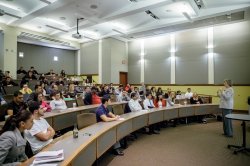Teaching Strategies for Large Classes Reference Sheet (quick reference guide; opens as PDF).
Lessons Learned from Teaching Large Classes (tips sheet with discussion, opens as PDF)
Michael Sandel, Harvard University, presents a lecture on morality and justice to a class of 700.
Teaching Frameworks for Large Classes
Peer Instruction
Peer Instruction – using clickers or student-response software to engage and transform large lectures.
- Peer Instruction was developed by Eric Mazur at Harvard University to implement Just-in-Time-Teaching (JiTT) concepts in large lecture classrooms using student response systems (clickers or polling software). This process has students work together on conceptual problems to find answers, surveys students as a formative means of assessing their learning, and then adapts the lecture to address misconceptions, bottlenecks, and other learning roadblocks. This is the foundational model to the “flipped” learning model, which has students prepare for class activities outside of class. To learn more about specific strategies using Peer Instruction, visit their blog, or watch the videos below to see the process in action.
- Another model of implementing Peer Instruction, or the “flipped” classroom model, with evidence-based research, from Kelly Logan at the University of North Carolina. Her research is available via open source creative commons licensing below.
Team-Based Learning (TBL)
team-based learning is a four-step process for structuring large classes for engagement, active learning, and high degrees of student participation and satisfaction. It uses pre-structured small groups and highly organized content-activities and assessments to keep students active and engaged for learning.
- Team-Based Learning from Faculty Innovation Center on Vimeo (examples of TBL in practice).
- For information on how to implement TBL, use this link to the step by step process with examples and supplemental materials.
Supplemental Instruction and Virtual Supplemental Instruction
Supplemental instruction (SI) is an academic support program using peer-led study sessions that targets traditionally difficult courses and can be adapted using Video-Based Supplemental Instruction (VSI) to large course sessions. Instructors record their lectures and students attend sessions with peer-instructors or TAs to help process and facilitate learning of the material.
- Uses a concept called Time to Think, as videos can be stopped and started based on where students feel stuck or get confused. Students formulate questions, make observations, and consider solutions as they work through the lecture with a peer-guide.
- Reinforces learning for peer-guides. Teaching is a highly effective way to reinforce or deepen content learning. SI has been proven through decades of research to increase student retention and learning across the disciplines.
Universal Design and Accessibility
- Designing for Universal learning through multimodal approaches. Learn more and access rubrics, course design models, and assignment templates on their web site.
Teaching Large Classes Online – Using Technology to Enhance Large Classes
- Polling software: Padlet, Polleverywhere, Mentimeter, Sli.do, and Kahoot! are easy to use and adaptable to phones, laptops, or tablets. They offer anonymity and instant feedback on what student’s know, believe, or think about a topic, and are great for active, engaged learning and prompting discussions.
- LMS – Canvas.
- Collaborative Learning – techniques for collaborative discussions, activities, and assignments.
- Break up large online classes by splitting off students to work either synchronously or asynchronously on exam prep, hold small group conferences and study groups, or invite Happy Half-Hour discussions where students can select topics (even non-course related) for discussion.
- Browse more tips here to break up large, long online classes.
References and Additional Reading
Strategies for Large Classes
Tony Spanakos and Josh Galster “Teaching Strategies for Large Classes: from Political Science to Earth and Environmental Science” Strategies for Large Classes – PowerPoint Doc
Structuring Large Course
Eddy, S.L. & Hogan, K.A. (2014) “Getting Under the Hood: How and for Whom Does Increasing Course Structure Work?” CBE—Life Sciences Education, Vol. 13, No. 3. https://doi.org/10.1187/cbe.14-03-0050.
Assessment and Grading
Glazer, N. “Formative Plus Summative Assessment in Large Undergraduate Courses: Why Both?” International Journal of Teaching and Learning in Higher Education 2014, Volume 26, Number 2, 276-286. http://www.isetl.org/ijtlhe/pdf/IJTLHE1703.pdf
Small-Group Learning in Large Classes
Jenay R., Lewis, S.E., Oueini, R. and Mapugay, A. “Coordinated Implementation and Evaluation of Flipped Classes and Peer-Led Team Learning in General Chemistry.” Journal of Chemical Education, 2016 93 (12), 1993-1998. https://pubs.acs.org/doi/10.1021/acs.jchemed.6b00395.
Sibley, J. & Ostafichuk, P. (2014). Getting Started with Team-Based Learning. Sterling, VA: Stylus.
Stone, M.E. & Jacobs, G. (Summer 2006) Supplemental Instruction: New visions for empowering student learning. New Directions for Teaching and Learning. San Francisco, CA: Jossey-Bass.
Engagement and Discussion in Large Courses
Cohen, D. (Jan. 2017) Class size matters. Inside Higher Ed. https://www.insidehighered.com/advice/2017/09/19/how-teach-large-classes-students-effectively-essay
Young, J.R. (Oct. 2017) When teaching large classes, professors shouldn’t try to put on a show. EdSurge. https://www.edsurge.com/news/2017-10-31-when-teaching-large-classes-professors-shouldn-t-try-to-put-on-a-show
